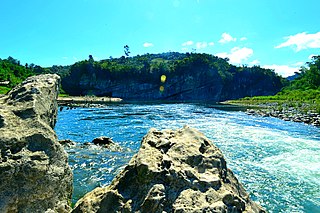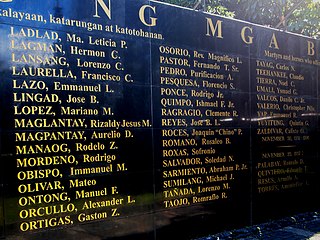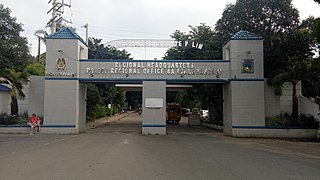
Quirino, officially the Province of Quirino, is a landlocked province in the Philippines located in the Cagayan Valley region in Luzon. Its capital is Cabarroguis while Diffun is the most populous in the province. It is named after Elpidio Quirino, the sixth President of the Philippines.

The 1986 Philippine presidential and vice presidential elections were held on February 7, 1986. Popularly known as the 1986 snap election, it is among the landmark events that led up to the People Power Revolution, the downfall of the presidency of Ferdinand Marcos, and the accession of Corazon C. Aquino as president.

Francisco "Soc" Aldana Rodrigo was a Filipino playwright, lawyer, broadcaster, and a Senator of the Philippines from 1955 to 1967.

Pi Sigma Fraternity (ΠΣ) is a socio-political fraternity based in the University of the Philippines Diliman. The fraternity commits itself to the principles of "Paglingkuran ang Sambayanan " and "Paragon of Scholarship." It was established in 1972.

The Free Legal Assistance Group (FLAG) is a nationwide organization of human rights lawyers in the Philippines. It was founded in 1974 by Sen. Jose W. Diokno, Lorenzo Tañada, J.B.L. Reyes, and Joker Arroyo during the martial law era under former President Ferdinand Marcos. It is the first and largest group of human rights lawyers established in the nation. They work on countering varied abuses against human rights and civil liberties. Its current chairman since 2003 is human rights attorney Chel Diokno, the founding dean of the De La Salle University Tañada-Diokno School of Law.

The Bantayog ng mga Bayani, sometimes simply referred to as the Bantayog, is a monument, museum, and historical research center in Quezon City, Philippines, which honors the martyrs and heroes of the struggle against the dictatorship of 10th President Ferdinand Marcos.
Student activism in the Philippines from 1965 to 1972 played a key role in the events which led to Ferdinand Marcos' declaration of Martial Law in 1972, and the Marcos regime's eventual downfall during the events of the People Power Revolution of 1986.
Antonio Maria "Tony" Onrubia Nieva was a Filipino journalist, union organizer, and activist. He worked to defend press freedom and the rights of workers, and campaigned to end authoritarian rule in the Philippines. He led the National Press Club as president and founded the National Union of Journalists of the Philippines. He was secretary general of the International Organization of Journalists based in Prague, Czech Republic, from 1995 up to the time of his death in 1997. His name is on the Bantayog ng mga Bayani Wall of Remembrance, for his contributions to the fight against injustices of the dictatorship under President Ferdinand E. Marcos.
Religious sector opposition against the dictatorship of President Ferdinand Marcos included leaders and workers belonging to different beliefs and denominations.

During the presidency of Ferdinand Marcos, Filipino workers in the labor industry experienced the effects of government corruption, crony capitalism, and cheap labor for foreign transnational industries, One of the objectives of Martial Law was to cheapen labor costs, in order to attract transnational corporations to export labor to the Philippines. Marcos signed many presidential decrees beneficial only to his associates, while allowing for the forced relocation of indigenous peoples, decreasing workers' wages, and murders of labor activists. Minimum wage was a fixed PHP8.00 per day. Many workers were unemployed or underemployed. It was also during the Marcos presidency when the practice of contractualization began, enabling managements to avoid giving regular, permanent status to employees after six months of work. Strikes were banned and the government controlled trade unions, leaving workers without effective protection against employers who had unfair labor practices and regulations.
Alexander "Alex" Orcullo was a Filipino journalist, community leader, and activist known for speaking against the abuses of the dictatorship of Ferdinand Marcos, and for being a seminal figure of the protest movement against the Marcos dictatorship in Mindanao, Philippines.

Melania Cristina Catalla was an anti-martial law activist who belonged to a network of community organizations in the Southern Tagalog region in the Philippines whose disappearance on July 31, 1977, became a rallying cry of the Philippine resistance against the Marcos dictatorship.
Captain Danilo Poblete Vizmanos, PN, Ret. was a Filipino activist and retired captain of the Philippine Navy. He is best known for his resistance against the Martial Law regime of former Philippine President Ferdinand Marcos. On November 30, 2016, Vizmanos' name was engraved on the Wall of Remembrance of the Bantayog ng mga Bayani, which honors the martyrs and heroes who fought against the Marcos dictatorship.

Gerardo T. Faustino was a Filipino student leader and activist from the University of the Philippines Los Baños who is best known as one of the most prominent desaparecidos of the Marcos Martial Law era in the Philippines.

Rev. Magnifico Libre Osorio was a Filipino Methodist Pastor and human rights advocate best known for championing the rights of Indigenous people in the province of Palawan and his murder during the waning days of Ferdinand Marcos' dictatorship in the Philippines. He was not known to have political affiliations nor leanings, but his humanitarian work and the circumstances of his murder have led him to be considered a martyr of the resistance against the dictatorship, and his name is inscribed on the Wall of Remembrance at the Bantayog ng mga Bayani in Quezon City.

Armando "Mandrake" Ducusin Palabay was a Filipino student leader and activist from San Fernando, La Union. He is best known for his work in organizing anti-Marcos campaigns during the first quarter storm and the early days of Martial law under Ferdinand Marcos. He was killed for the anti-Marcos cause while doing community work among the indigenous Tingguian people of Sallapadan, Abra, in 1974, and was honored in 2001 by having his name inscribed on the Wall of the Remembrance at the Philippines' Bantayog ng mga Bayani, which honors the martyrs and heroes who fought the dictatorship.

David Triunfante Bueno was a Filipino human rights lawyer and radio show host from Ilocos Norte, best known his work as the most prominent human rights lawyer in Ilocos Norte during the later part of the Marcos administration and the early part of the succeeding Aquino administration. He was a member of the prestigious group called the Free Legal Assistance Group or FLAG, the oldest and largest group of human rights lawyers in the country.

Camp Vicente Lim is a facility of the Philippine National Police located in Barangay Mayapa in the City of Calamba, Laguna, which currently serves as the regional headquarters of the PNP in Calabarzon. It has played a significant part in the local history of the Calabarzon region, as well as the national history of the Philippines; it was part of the Calamba Airstrip during the Philippines' American Colonial era, and was occupied by the Japanese during World War II although it is not recorded as having been used for military purposes during the war. It later became a facility of the Philippines' integrated local police forces, hosting the Integrated National Police Training Command. During Martial law under Ferdinand Marcos, Camp Vicente Lim was one of the four provincial camps to be designated a Regional Command for Detainees (RECAD). It was designated RECAD I and it housed thousands of political detainees from the Southern Tagalog and Bicol regions.

Arturo Montemayor Taca was a Missouri-based Filipino surgeon, urologist, writer, and activist best known as one of the leaders of the Movement for a Free Philippines (MFP), a US-based organization established by exiled Filipinos in opposition to the authoritarian regime of Ferdinand Marcos in the Philippines. He is honored as a hero of the fight for Philippine democracy, having his name inscribed on the Wall of Remembrance of the Philippines' Bantayog ng mga Bayani memorial in 2011
Historians estimate that there were about 70,000 individuals incarcerated by the authoritarian regime of Ferdinand Marcos in the period between his 1972 declaration of Martial Law until he was removed from office by the 1986 People Power Revolution. This included students, opposition politicians, journalists, academics, and religious workers, aside from known activists. Those who were captured were referred to as "political detainees," rather than "political prisoners," with the technical definitions of the former being vague enough that the Marcos administration could continue to hold them in detention without having to be charged.














